US EAST COAST 2012 - HFMWeek
US EAST COAST 2012 - HFMWeek
US EAST COAST 2012 - HFMWeek
You also want an ePaper? Increase the reach of your titles
YUMPU automatically turns print PDFs into web optimized ePapers that Google loves.
<strong>US</strong> <strong>EAST</strong> <strong>COAST</strong> <strong>2012</strong><br />
THE REAL RISK OF<br />
FAKING IT<br />
DID THE IND<strong>US</strong>TRY LEARN FROM THE 2008 CRISIS ARE RISKS BEING PROPERLY MONITORED OR ARE WE DESTINED TO HEAD INTO<br />
THE SAME STORM AGAIN DAMIAN HANDZY, OF INVESTOR ANALYTICS, TALKS TO HFMWEEK ABOUT THE REAL COSTS OF NOT<br />
ANTICIPATING AND MANAGING RISK<br />
Damian Handzy,<br />
CEO, co-founded Investor<br />
Analytics in 1999 to provide<br />
risk management services<br />
to the alternatives industry.<br />
He was named chairman<br />
and CEO in 2006 and has<br />
grown Investor Analytics into<br />
one of the global leaders<br />
in risk analysis and risk<br />
management solutions.<br />
18 HFMWEEK.COM<br />
Damian Handzy, the CEO of Investor Analytics,<br />
observed in a recent white paper<br />
that the financial crisis served to remind<br />
us that a free market provides the means<br />
to win and to lose – but he added that not<br />
all financial managers followed the major<br />
markets into free fall in the aftermath of 2008. The managers<br />
who successfully navigated the crisis, said Handzy,<br />
understood and acted on the three tenets of risk management:<br />
(1) all risk models have built-in assumptions that<br />
are not applicable in every circumstance; (2) correctly<br />
analysing the data takes real expertise; and (3) model<br />
limitations can only be ignored at great peril. <strong>HFMWeek</strong><br />
spoke to Handzy recently to get his views on the current<br />
state of risk management – have managers reset their approach<br />
to risk management or is there still over-dependence<br />
on models as a substitute<br />
<strong>HFMWeek</strong> (HFM): Given the number of financial<br />
events that have happened, even since 2008, do you<br />
think managers learned some real risk management<br />
lessons<br />
Damian Handzy (DH): The real question is, did we learn<br />
any lasting lessons I hope we did, but as a student of human<br />
behaviour, I know that we all have selective memories,<br />
which is why we often have to repeat our mistakes to<br />
learn from them. When times are good, it’s our nature to<br />
want to believe that what goes up will keep going up even<br />
though we have a mountain of evidence to contradict<br />
that notion. In 2008, we were reminded once again of<br />
the very high cost of ignoring history, a mistake that still<br />
haunts the industry. However, the<br />
events did open up a healthy and, I<br />
believe, lasting dialogue about the<br />
importance of real risk analytics<br />
and management versus just having<br />
models that measure various<br />
statistical outputs.<br />
IN 2008, WE WERE<br />
REMINDED ONCE AGAIN<br />
OF THE VERY HIGH COST<br />
OF IGNORING HISTORY,<br />
A MISTAKE THAT STILL<br />
HAUNTS THE IND<strong>US</strong>TRY<br />
”<br />
HFM: Was ‘don’t put all your<br />
eggs in one basket’ better risk<br />
management<br />
DH: The multiple basket approach<br />
only works to a degree.<br />
The idea behind it is, of course,<br />
diversification, which requires uncorrelated<br />
investments. But during<br />
a market event like 2008, almost every investment<br />
became very highly correlated with everything else. As<br />
a lot of assets become contaminated, the opportunity to<br />
diversify was reduced.<br />
That’s where hedging strategies and stress testing<br />
come into play. In this case, what you’re stressing is<br />
model assumptions – like correlations – to measure the<br />
portfolio’s risks in highly correlated markets. Stressing<br />
correlations is key to understanding how well diversified<br />
the portfolio really is. At Investor Analytics, we’ve been<br />
providing stress testing as part of our system for years.<br />
The ‘correlation goes to one’ stress is simple to understand<br />
and provides a lot of useful information.<br />
HFM: What is the highest barrier to companies adopting<br />
a risk management culture<br />
DH: There are both cost and human factors at play in<br />
the decision to integrate more robust risk controls. First,<br />
we are in a challenging economy where everyone is being<br />
asked to contribute more with less and where resources<br />
are scarce. An existing risk system, whether built inhouse<br />
or purchased in the past, may seem like a low-cost<br />
approach if the direct expenditure is low. But that lowcost<br />
system is probably not scalable or capable of handling<br />
today’s portfolios or markets.<br />
Possibly even more important is the human factor –<br />
who is going to control the risks taken by the portfolio<br />
managers Who is going to have the authority to tell a<br />
portfolio manager to de-lever or reduce risk if they are<br />
exceeding thresholds A risk management culture starts<br />
with – or dies from – the top. If the head trader or CEO<br />
doesn’t buy into a risk management<br />
culture, it’s difficult to implement<br />
such a system effectively.<br />
HFM: What are the biggest challenges<br />
facing your clients<br />
DH: Certainly there has been a<br />
significant change in the number<br />
of stress tests being conducted<br />
and the depth of detail that investors<br />
and regulators alike are now<br />
demanding. For example, the<br />
SEC-mandated Form PF now requires<br />
certain hedge funds to submit<br />
on a regular basis analytics for<br />
a variety of stress tests in addition











